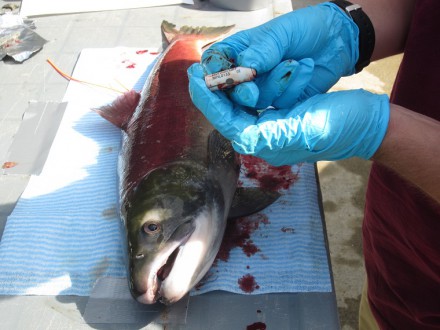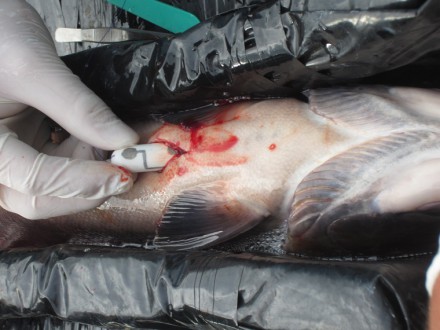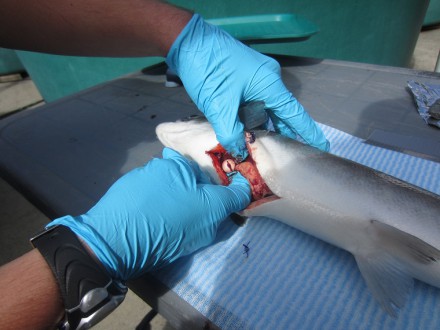- Sensor tags are helping quantify how animals interact with humans and their environment.
- The technology faces limitations of cost and scale, ethical decisions, and the challenges of big data analysis.
- In the future, sensor tags could inform conservation science and offer a diffuse, animal-mounted view of a changing world.
For wild sockeye salmon, the trip upriver from the ocean to their spawning grounds is fraught with peril and hardship. But quantifying exactly how obstacles along the way, fluctuations in water temperature and other factors impact fish survival has long eluded researchers. New advances in biological sensor tags are now allowing scientists to precisely measure animals’ energetics, their interactions with humans, and their responses to rapidly changing environments.

In 2014, for example, Nicholas Burnett and colleagues used accelerometer tags to measure how salmon needed to swim in order to traverse a dam in the Seton-Anderson watershed of British Columbia, Canada and how likely they were to survive the remainder of their journey. They found that when salmon resort to strenuous anaerobic swimming, they were significantly more likely to die days or even hours later.
In “Utility of biological sensor tags in animal conservation,” an article in the current issue of Conservation Biology, Wilson et al. (2015) survey the use of biological sensor tags and make the case that such tools deserve a central place in the conservation toolbox. Other tags, including biotelemetry and biologging tags, are already widely used and have helped researchers understand where and how animals move. But as a new, versatile generation of sensor tags become used more broadly and are adopted in a broader array of species, they could deepen our understanding of how animals interact with the environment and shape wildlife-management policy and decision-making.
Here are answers to a few questions about sensor tags:
Why use them?
Wilson et al. (2015) highlight four areas of conservation where biological sensor tags are most useful: for “quantifying the impact of human disturbance on wild animals; understanding and predicting the impact of environmental change; understanding the consequences of habitat selection and animal movement; and implications for animal energetics.” For instance, one research group used heart-rate monitors shaped like eggs to measure how ecotourism affected stress levels in breeding yellow-eyed penguins. Another group tracked the movements and body temperature of Arabian oryx (Oryx leucoryx) to examine how the antelope might respond to climate change. Researchers have also used accelerometers to show that some turtles search for warmer water to hasten the development of their eggs. Finally, researchers could monitor birds’ heart rate and wing beat frequency to determine the energetic cost to birds detouring around human-made obstacles in a flyway.

What parameters can they measure?
The tags can asses a broad array of physiological factors, such as locomotor activity, cardiac activity, ventilation rate, neural activity, body temperature and body fluid chemistry. Quantifying an animal’s movements could allow researchers to understand the consequences of an animal’s interactions with humans or assess the costs and benefits of a particular habitat. Measuring circulation and breathing would allow for an unbiased assessment of animal stress. Although tags that measure neural activity are still in their infancy, they could help researcher understand decision-making and animal sleep patterns in situ. Finally, temperature and body fluid tags could assess an individual’s health in a variety of environments.
Sensors can be used to measure surprisingly nuanced elements of an animals behavior: logging every time a fish opens its mouth, for example, or demonstrating that the Alpine Swift can fly nonstop for six months.
Why aren’t more people using them?
Steven Cooke — Canada research chair in fish ecology and conservation physiology, director of the Institute of Environmental Science at Carleton University and an author on the Wilson study — sees several factors that have limited the tags’ use: “They take some tinkering!” he wrote in an email, especially when researchers adapt them to new species. The units are expensive, which could deter wildlife managers, because the sample sizes in studies are generally small. “We still need to work on scaling up from individuals to populations,” Cooke wrote. Finally, each tag generates a massive dataset, which can pose significant analytical challenges.

What are their limitations?
As with all new technologies, size and battery life could be improved. In addition, Cooke would like to see a greater variety of sensors, especially those that assess an animal’s internal state: “glucocorticoid hormones, reproductive hormones, blood lactate, etc.”
Some tags also require time-consuming anesthetizations and surgeries and the placement of equipment near an animal’s vital organs. According to Kays et al. (2015) in “Terrestrial animal tracking as an eye on life and planet,” all tag research raises an ethical issue about the cost/benefit of tagging animals, because the devices inevitably place an animal at some risk. But as tags decrease in size, their impacts on an organism generally diminish. “Reducing the negative impacts of these tags is a priority not only for ethical reasons, but also to ensure that the data collected accurately reflect the behavior of the species being studied,” the authors explain.
To measure some parameters, researchers need to adopt what Christopher Wilmers and colleagues call a “Laboratory-to-field” approach: Sensors are first calibrated on a captive individual or a proxy species before being deployed in the wild.
What are some tips for researchers?
“Don’t assume that it is ‘out of the box’ technology,” Cooke wrote. “There are limitations and challenges, so [it’s] best to understand them up front.”
An aptitude for electronics and a willingness to experiment come in handy when using tags, Cooke indicated: “We always encounter challenges when porting to a different species, so be prepared for tinkering with attachment and sensor placement (especially for finicky ones like heart rate).”
That said, as more commercially manufactured devices become available, the technology is becoming available to researchers less prone to tinker. “It’s not like you have to go into your garage and start soldering (although I encourage you to do so!!!),” Cooke wrote.

A new tool
Although fitness trackers such as Fitbit and Jawbone are often abandoned when wearers tire of failing to reach their daily goal of 10,000 steps, similar technology could be a valuable addition to the conservationist toolbox. As Wilson et al. (2015) write, “Given the links between behavior and physiology… sensor tags provide unique opportunities to integrate paradigms and perspectives from these two disciplines to yield a more holistic and integrated conservation science.”
Other researchers have even more grandiose ideas about what sensor technologies can do, especially when coupled with GPS tracking. Kays and colleagues think the revolution in sensor technologies will shift the reasons researchers deploy sensors: Instead of using sensors to learn about animals, sensors will let animals teach us about the world. “The concept of animals as in situ sensors of our environment has only begun to be explored in the terrestrial realm… a new approach that views animals as naturally evolved sensors of the environment has the potential to help us monitor the planet in completely new ways,” they write.
Have you used a sensor tag? Can you imagine some novel uses for the technology? Tell us about it in the Wildtech Forum.
Citations:
Burnett, N. J., Hinch, S. G., Braun, D. C., Casselman, M. T., Middleton, C. T., Wilson, S. M., & Cooke, S. J. (2014). Burst swimming in areas of high flow: delayed consequences of anaerobiosis in wild adult sockeye salmon. Physiological and Biochemical Zoology, 87(5), 587-598.
Kays, R., Crofoot, M. C., Jetz, W., & Wikelski, M. (2015). Terrestrial animal tracking as an eye on life and planet. Science, 348(6240), aaa2478.
Wilmers, C. C., Nickel, B., Bryce, C. M., Smith, J. A., Wheat, R. E., & Yovovich, V. (2015). The golden age of bio-logging: how animal-borne sensors are advancing the frontiers of ecology. Ecology, 96(7), 1741-1753.
Wilson, A. D. M., Wikelski, M., Wilson, R. P., & Cooke, S. J. (2015). Utility of biological sensor tags in animal conservation. Conservation Biology.